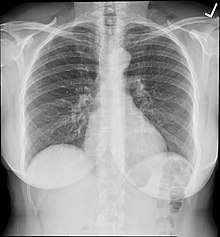Bucky-Potter grid
The Bucky-Potter grid is a device invented by German radiologist Gustav Bucky and improved by American radiologist Hollis E. Potter that enhances the quality of diagnostic medical x-ray images. The grid is positioned on the opposite side of the patient from the x-ray tube to reduce the quantity of scattered x-rays that reach the X-ray detector. Reducing the amount of scattered x-rays increases the image’s contrast resolution and, consequently, the visibility of soft tissues.

Operation
Scattered x-rays do not travel in parallel to rays that pass directly through the patient. The quantity of scattering depends on several factors including: x-ray beam area, x-ray photon energies (determined by tube voltage setting), thickness of the tissue, and the composition of the tissue.[1] By 'rejecting' scattered x-rays before they reach the detector, the Bucky-Potter grid improves recorded contrast. However, use of the device requires an increase in x ray beam intensity (by increasing both tube voltage [kV] and tube charge [mAs]). This leads to increase in the amount of radiation absorbed by the patient. Scatter rejection grids are therefore omitted where possible, especially in paediatric practice.
Gustav Bucky (1880-1963) showed in 1913 that a grid can be used to 'reject' scattered x-rays before they reach the detector. The grid is composed of alternating strips of an x-ray absorbent material (such as lead) and an x-ray transparent material (such as plastic, fiber, or aluminium). The grid’s performance is related to the ratio of the height of the absorbent strips (typically up to 5 millimeters) to the distance between the strips (typically 0.4 millimeters or less). Grid ratios of 5:1 to 16:1 are used most often. Though higher ratios are possible, they require greater radiation intensity increases when used, require more precise positioning, and are more expensive to produce.[2]
One drawback of a fixed radiographic grid is that it creates grid lines on the image (see the chest x-ray shown in the article). Hollis Potter (1880-1964) showed in 1920 that these grid lines could be eliminated by moving the grid at right angles to the grid lines during the exposure. If the range and speed of motion is sufficient, the grid lines will be blurred out. The motion may be oscillating, vibrating, or reciprocating and must be continuous and smooth. The motion must also begin before exposure and continue until after exposure.
The Bucky-Potter grid facilitated the transition from small glass photographic plates to film in a variety of sizes.[3]
References
- Perry Sprawls, Ph.D. (Fall 2013). "Scattered Radiation and Contrast". Sprawls.org. Sprawls Educational Foundation. Retrieved January 28, 2014.
- "Radiology Chapter Seven: Grids". Tuskegee.edu. Tuskegee University. 2013. Archived from the original on March 26, 2015. Retrieved September 5, 2016.
- Kevles, Bettyann (1998). Naked to the Bone: Medical Imaging in the Twentieth Century. Basic Books. pp. 65–66. Retrieved January 28, 2014.